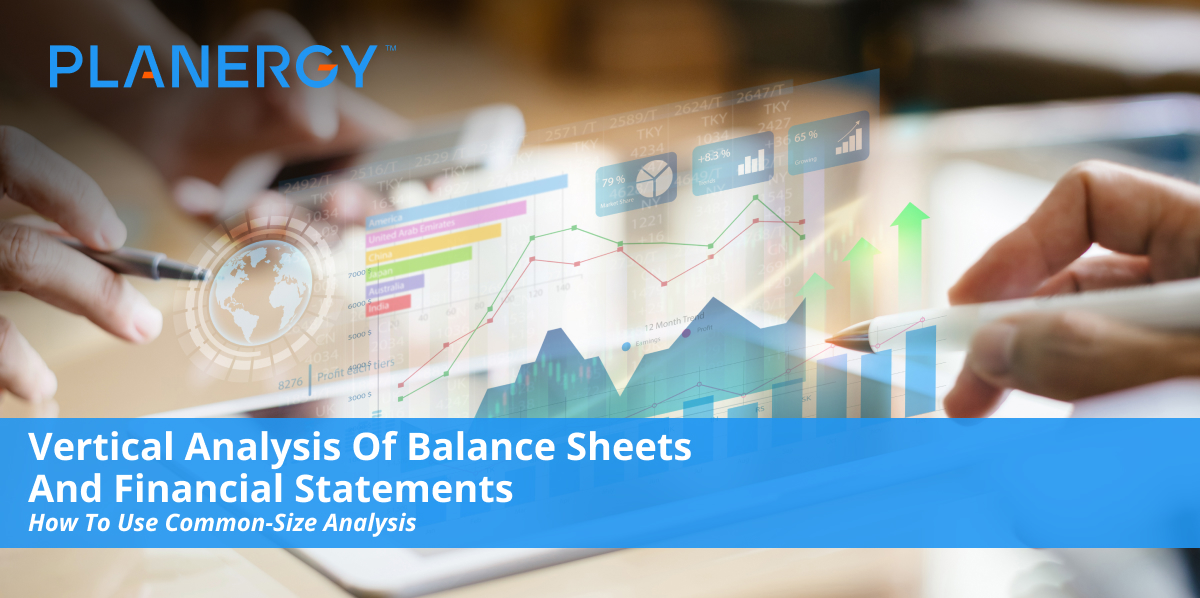Vertical analysis is a proportional analysis of financial statements. Also known as common-size analysis, vertical analysis can help analyze company performance, but it is also a useful tool for comparing the financial statements of two companies.
Vertical analysis can also be used to spot trends over a specific period of time.
Vertical analysis can be used with both income statements and balance sheets, with every line item on the financial statement entered as a corresponding percentage of the base item.
Vertical analysis is typically used for a single accounting period, whether that’s monthly, quarterly, or annually, and can be particularly helpful when used to compare data for several accounting periods.
What is vertical analysis?
Vertical analysis of financial statements is where each line item on your company’s financial statement is listed as a percentage of the base figure on the statement.
For example, if vertical analysis is used on an income statement, gross sales (not net sales) would be the base figure and all other line items a percentage of total sales.
When used with your company’s balance sheet, total assets or total liabilities would be used as the baseline figure, with all subsequent line items shown as a percentage of that total.
Typically used for a single accounting period, vertical analysis is extremely useful for spotting trends.
Though a useful tool on its own, vertical analysis can be a more useful tool when used in conjunction with horizontal analysis.
The difference between horizontal and vertical analysis
Vertical analysis uses percentages in its analysis, restating either income statement or balance sheet items as a percentage.
For example, if you’re using vertical analysis with a balance sheet to analyze your assets, your base amount would be your total assets, with each individual item given a percentage in the next column.
The same would apply when performing a vertical analysis of your liabilities.
| 2021 Balance Sheet | $ Totals | Percent |
| Cash | $100,000 | 20% |
| Accounts receivable | $200,000 | 40% |
| Inventory | $ 75,000 | 15% |
| Total Current Assets | $375,000 | 75% |
| Fixed assets | $125,000 | 25% |
| Total Assets | $500,000 | 100% |
Balance sheet vertical analysis uses total assets as a base and assigns a percentage to all line items.
In this example of vertical analysis, you can see that you only need to use balance sheet items from a single accounting period.
While we’re only showing account balances for assets on this vertical analysis, the same process would be completed for your liability accounts, with your total liabilities and equity serving as your baseline number.
By looking at the balance sheet, you can see that the majority of your company’s assets are current, with only 25% of assets considered fixed, or long-term assets.
| 2020/2021 Balance Sheet | 2021 Totals | 2020 Totals | Increase/Decrease | Percent |
| Assets | ||||
| Cash | $100,000 | $ 95,000 | $ 5,000 | 5.3% |
| Accounts receivable | $200,000 | $225,000 | ($25,000) | (11.1)% |
| Inventory | $75,000 | $ 60,000 | $15,000 | 25.0% |
| Total Current Assets | $375,000 | $380,000 | ($5,000) | (1.3)% |
| Fixed assets | $125,000 | $105,000 | $20,000 | 19.0% |
| Total Assets | $500,000 | $485,000 | $15,000 | 3.1% |
When using horizontal analysis, balance sheet totals for two periods are required.
On the other hand, horizontal analysis looks at changes in specific dollar amounts for each period, highlighting the changes line-by-line over two specific accounting periods.
Horizontal analysis also displays percentage change for each balance sheet item as well.
Vertical analysis is useful for single accounting period analysis, while horizontal analysis is used to compare company performance between two specific accounting periods, whether it’s quarterly or annually.
In the above example, we’re comparing company performance for 2021 and the previous year, which was 2020.
By looking that the balance sheet above, you can see that while your current asset total went down in accounts receivable, your fixed asset total went up.
While vertical analysis is a great tool for analyzing your current financial position, horizontal analysis is better for spotting trends between two accounting periods.
If your vertical analysis reveals unusual trends or variances, take the time to investigate these changes.
The formula for calculating vertical analysis
The formula for calculating vertical analysis is simple. Using the 2021 balance sheet numbers, we’ll calculate the percentages using the following formula:
Individual Line Item / Total Assets x 100 = Vertical Analysis Percentage
As an example, we’ll calculate the Cash total from the balance sheet above.
$100,000 / $500,000 x 100 = 20%
To complete a vertical analysis for your balance sheet, you’ll need to perform this calculation for each line item that is currently listed on your balance sheet.
| 2021 Balance Sheet | $ Totals | Percent |
| Cash | $100,000 | 20% |
| Accounts receivable | $200,000 | 40% |
| Inventory | $ 75,000 | 15% |
| Total Current Assets | $375,000 | 75% |
| Fixed assets | $125,000 | 25% |
| Total Assets | $500,000 | 100% |
| Accounts payable | $150,000 | 30% |
| Total Current Liabilities | $150,000 | 30% |
| Notes payable | $100,000 | 20% |
| Total Liabilities | $250,000 | 50% |
| Stock | $175,000 | 35% |
| Retained earnings | $ 75,000 | 15% |
| Total Equity | $250,000 | 50% |
| Total Liabilities and Equity | $500,000 | 100% |
Both assets and liabilities/equity have a base number assigned, which is always 100%.
Steps to prepare vertical analysis with your balance sheet
Before you can begin to use vertical analysis, there are a couple of steps you must follow.
- Prepare your balance sheet
Before you can begin a vertical analysis, you must first have a current balance sheet prepared for the accounting period that you wish to analyze.
If you’re preparing the balance sheet manually, be sure that your asset totals balance with your liability and equity totals.
- Calculate percentages for each line-item account
Once your balance sheet totals are ready, you’re ready to complete your vertical analysis.
This is done by calculating your line item totals as a percentage of your base number.
For example, if your base number is $500,000 and your line-item total is $100,000, your percentage is calculated as follows:
$100,000 / $500,000 x 100 = 20%
Remember, on a balance sheet, your base number is always your total assets and total liabilities, and equity.
- Analyze the results
To complete a vertical analysis, you’ll first need to determine what information you’re looking to obtain.
For example, many businesses use vertical analysis to compare their financial results to those of other businesses in their industry.
Because vertical analysis deals with percentages rather than totals, using vertical analysis makes it easy to compare company performance with other companies, even those of different sizes.
Other businesses use vertical analysis over several accounting periods to detect trends or variances.
Vertical analysis can be particularly helpful if looking to determine cash and accounts receivable balances over several accounting periods.
If your analysis reveals unusual trends or variances, take the time to investigate these changes.
For example, a significant increase in your accounts receivable balance and a noticeable decrease in cash can signal difficulty in collecting payments from your customers.
If this continues over several months, revisiting credit practices or collection methods may be in order.
Another potential trouble spot may be an increase in inventory and a decrease in cash, signaling that your inventory movement is sluggish.
Again, keep in mind that these examples only become an issue if they occur consistently over several accounting periods, which is why it’s so important to perform vertical analysis regularly.
Advantages of using vertical analysis for your business
There are several reasons why using vertical analysis can be advantageous for your business.
- Simplicity: Both vertical and horizontal analysis offers some of the easiest ways to analyze company finances.
- Spotting trends: Whether used with a balance sheet or an income statement, vertical analysis is an easy way to compare current results with those from a previous accounting period.
- It can help spot potential issues: Vertical analysis can help you pinpoint trouble areas early, allowing you to take corrective action before the problem gets out of hand.
- Comparison: It can be difficult to measure your company’s performance against another similar company. But using vertical analysis, the emphasis on percentages allows you to make those comparisons seamlessly.
- Useful tool for goal-setting: Vertical analysis allows you to use the results of your latest analysis to set goals. For example, if your cash percentage is 15% and your accounts receivable percentage is 30%, you can choose to set a goal of 35% cash and 10% accounts receivable.
Disadvantages of using vertical analysis for your business
There are advantages and disadvantages to everything, including using vertical analysis. Here are just a few of them.
-
Results may require additional research: While vertical analysis can provide percentages of your base number, it doesn’t provide you with the information you need to make any changes. Using the accounts receivable example above, vertical analysis can provide you with cash and accounts receivable percentages, but the percentages don’t tell you why your cash percentage is so much lower than your accounts receivable percentage. Only additional research into your credit procedures and collection activities can give you those answers.
- It only provides a small portion of financial data: The information provided by vertical analysis is certainly useful, but it’s only a small portion of the information you will need to run your business profitably. You’ll still need to look at your cash flow statement, liquidity, and net income; none of which can be obtained by vertical analysis.
- It provides better information when used with horizontal analysis: While business owners can certainly use vertical analysis regularly on their own, it becomes more useful when used in combination with horizontal analysis which provides a better look at the changes that occur between accounting periods.
Analysis of the balance sheet can take many forms, with vertical analysis just one of them.
Vertical analysis can provide business owners and CFOs with valuable information, particularly when used with additional financial ratio analysis.
While vertical analysis cannot answer why changes have taken place, it’s a useful tool for trend analysis along with pinpointing areas that need further investigation.




